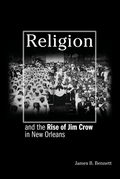

 |
James B. Bennett. Religion and the Rise of Jim Crow in New Orleans. Princeton and Oxford: Princeton University Press, 2005. xiv + 305 pages. ISBN: 0-691-12148-6. Reviewed by Edward J. Blum, for the Journal of Southern Religion.
Renowned for its French Quarter, its Creole cuisine, its multi-racial and multi-national history, and of course its Mardi Gras, New Orleans is one of a kind. And after James Bennett's Religion and the Rise of Jim Crow in New Orleans, the city should also be remembered for a curious religious and racial development. Two decades after the Civil War, the city's two most prominent Christian denominations – the Catholic Church and the Methodist Episcopal Church – maintained a high degree of interracial activity. But from the 1880s to the 1920s, both denominations were transformed as Jim Crow took a place of honor in the churches. As Bennett details with clarity and sharpness, denominational segregation in New Orleans was a painful struggle that was neither inevitable, nor foreseeable. Rather, religious endorsement of Jim Crow went a long way to sanctifying segregation as a widespread social reality.
The first half of Bennett's study details the undoing of interracial Methodism in the Crescent City, while the second half examines that process in the Catholic Church. As Bennett shows, while white and black Methodists were largely segregated at the local level, they interacted at regional and national conventions. Perhaps most impressively, black Methodists and their white supporters joined together to criticize racial injustice in the denomination, the city, and the United States. They seemed to share the belief that the church was a powerful moral and social institution that should strike a blow for human rights. But during the 1890s and first decades of the twentieth century, African American Methodists lost most of their white friends, and denomination leaders accepted segregation within the church hierarchy. The outcome for Catholics was the same, but the experiences and motivating forces were quite different. It was whites' neglect of African Americans, not idealism for racial inclusion, that maintained interracialism among New Orleans Catholics at first. Only when Francis Janssens, archbishop of New Orleans, took an interest in local Catholics of color did he decide to create segregated facilities. African American Catholics resisted, but after a series of clandestine decisions, white leaders effectively segregated white and black Catholics. The processes were different, but the outcomes were the same – race trumped religious affiliation.
|
|
| "As Bennett details with clarity and sharpness, denominational segregation in New Orleans was a painful struggle that was neither inevitable, nor foreseeable." |
|
|
Religion and the Rise of Jim Crow in New Orleans follows a decade of historical work on religion, race, and the American South from the Civil War to World War I. Beginning with Daniel Stowell's Rebuilding Zion and continuing through a host of marvelous studies, including Paul Harvey's Freedom's Coming , Evelyn Brooks Higginbotham's Righteous Discontent, W. Scott Poole's Never Surrender, and Gaines Foster's Moral Reconstruction, scholars have begun to show that religion was central to changes in post-Civil War America. Churches, church people, and church rhetoric, Bennett and these others have demonstrated, were vital in legitimizing and challenging segregation, “redemption,” lynching, and imperialism.
But unlike Harvey, Brooks Higginbotham, and Poole, Bennett does not delve into the everyday lives of religious folk. Most of his source material comes from ministers, priests, and editors. What the people in the pew felt, thought, or believed remains unspoken. The lack of analysis of personal diaries and letters from common folk may explain why Bennett was unable to discover theological rationales for segregation. At the grassroots level, however, there were plenty of theological justifications for Jim Crow. The amazingly successful novels of minister-turned-writer Thomas Dixon, Jr., were in effect religious briefs for segregation, if not African American annihilation. And more explicitly, the white supremacist theological works of Charles Carroll, who asserted time and again that people of color were not people and had no souls, garnered a wide readership at the turn of the century. It wasn't that southern whites didn't have a theology for segregation; rather, a theology of white supremacy was advanced during dinner conversations, out fishing, or while listening to stories of the Confederate past. Finally, Bennett concludes by suggesting that the Civil Rights movement of the 1950s and 1960s “turn[ed] back the tide of Jim Crow and move[d] African Americans ever closer to the elusive Promised Land.” (235) But this isn't true, at least if we are discussing segregation in American churches. As sociologists Michael Emerson and Christian Smith have shown in their study of race and religion during the 1990s, about 90% of African Americans attend predominately black congregations and at least 95% of white Americans attend predominately white churches.(1) Jim Crow has yet to be dethroned in American religion. Bennett's study helps explain the process by which Jim Crow ascended, but we should not pretend as if the Civil Rights Movement has pulled him down.
Edward J. Blum, Associate Editor, Kentucky Historical Society
1. Michael O. Emerson and Christian Smith, Divided By Faith: Evangelical Religion and the Problem of Race in America (New York: Oxford University Press, 2000).
© 1998-2005 by The Journal of Southern Religion. All rights reserved. ISSN 1094-5253